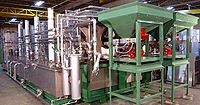Difference between revisions of "Feeding Hoppers"
PurplePen19 (talk | contribs) |
|||
| Line 1: | Line 1: | ||
[[Category:Silos, Hoppers]]{{Knoppen}} | [[Category:Silos, Hoppers]]{{Knoppen}} | ||
[[File:Feeding Hoppers.jpg|thumb|200px|right|Feeding Hoppers]] | [[File:Feeding Hoppers.jpg|thumb|200px|right|Feeding Hoppers]] | ||
'''Feeding Hoppers''' are commonly used for feeding the fine opened and blended fiber to the even batt then feed to the next process. These hoppers are new types of feeding equipment installed in various feed bin bottom. It makes the material loose though vibration so that it can eliminate the material arching camber, blocking, attaching and solve silo discharging problem. | '''Feeding Hoppers''' are commonly used for feeding the fine opened and blended fiber to the even batt then feed to the next process. These hoppers are new types of feeding equipment installed in various feed bin bottom. It makes the material loose though vibration so that it can eliminate the material arching camber, blocking, attaching and solve silo discharging problem. | ||
Latest revision as of 05:48, 16 March 2014
Feeding Hoppers are commonly used for feeding the fine opened and blended fiber to the even batt then feed to the next process. These hoppers are new types of feeding equipment installed in various feed bin bottom. It makes the material loose though vibration so that it can eliminate the material arching camber, blocking, attaching and solve silo discharging problem.
Common Features
- Simple structure
- vibration motor smooth running.
- Easy maintenance.
Operation Principles
Parts are fed on a continuous inline basis by moving the parts through various operations in a horizontal cylinder that is equipped with an internal helix. This causes parts to advance as the drum rotates. The parts are gently tumbled in the washing, rinsing and inhibiting solutions. This part movement exposes all surface, edges and geometries to the immersion soak and spray cleaning action as well as effectively draining and exposing all part surfaces to the dyer air flow.
